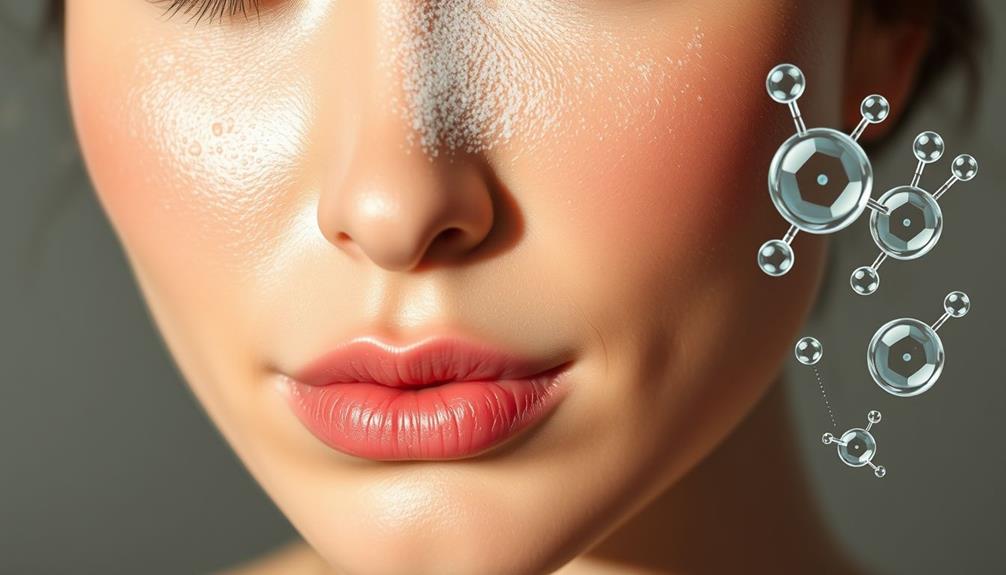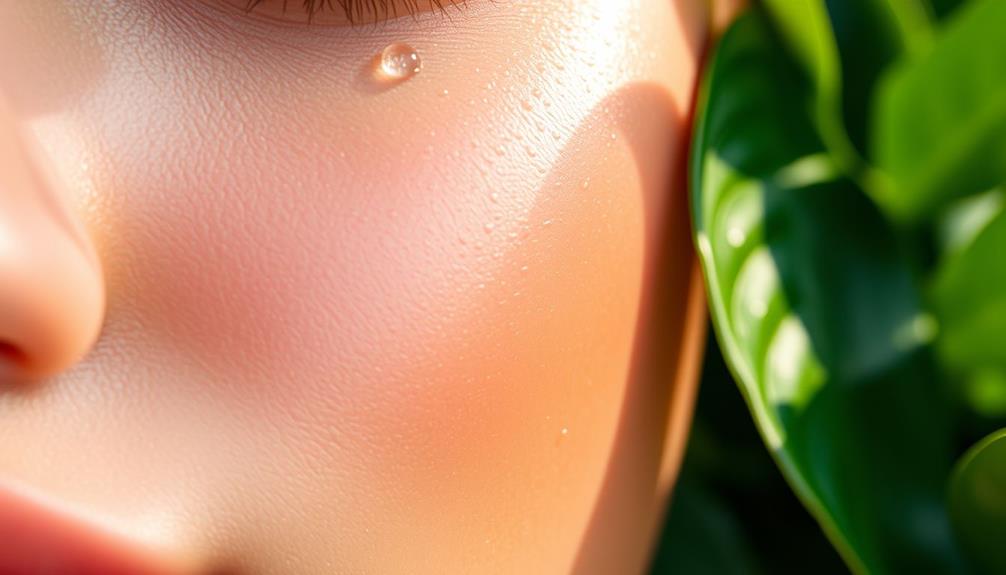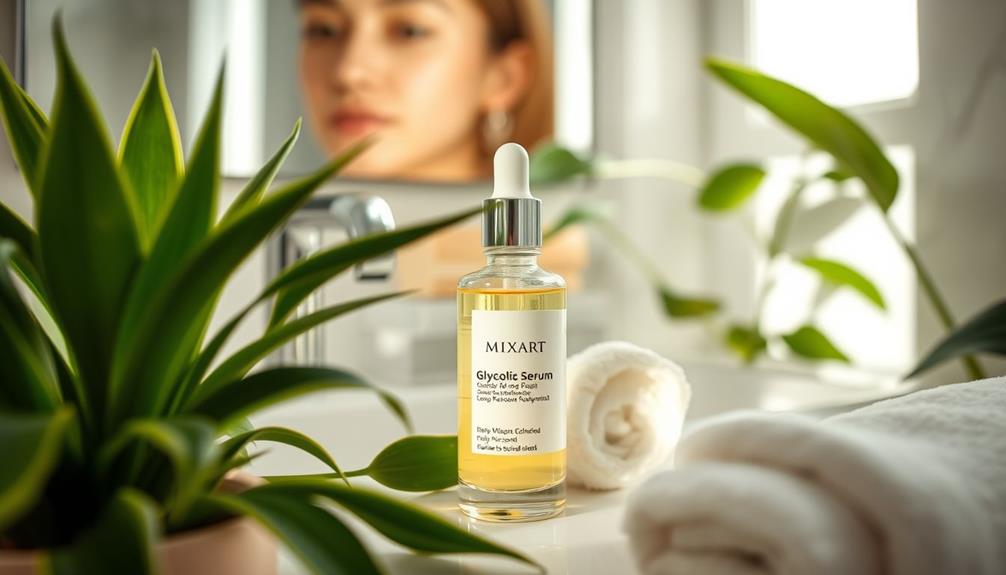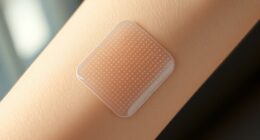Glycolic acid is a powerful exfoliant that transforms your skin by removing dead cells, revealing a smoother and more radiant complexion. It stimulates collagen production, helping to reduce fine lines and wrinkles, while fading dark spots for an even skin tone. You can find glycolic acid in various products like cleansers and serums, making it easy to incorporate into your routine. Start with a lower concentration to gauge your skin's tolerance, and remember to use sunscreen since it can increase UV sensitivity. There's so much more to discover about maximizing glycolic acid's benefits for your skin!
Key Takeaways
- Glycolic acid exfoliates dead skin cells, revealing smoother, fresher skin and improving overall texture and clarity.
- It stimulates collagen production, reducing fine lines and promoting a firmer, more youthful appearance.
- Glycolic acid effectively fades dark spots and hyperpigmentation, leading to a more even skin tone.
- Regular use clears clogged pores, making it beneficial for acne-prone skin.
What Is Glycolic Acid?

Glycolic acid is a powerful alpha hydroxy acid (AHA) derived from sugar cane that penetrates the skin deeply and effectively exfoliates to reveal a smoother, more radiant complexion.
As a chemical exfoliant, it works by loosening and removing dead skin cells, which helps to improve skin texture and clarity. This potent acid is celebrated for its anti-aging benefits, as it stimulates collagen production, promoting skin firming and reducing the appearance of fine lines.
Additionally, incorporating natural elements like essential oils for relaxation can enhance your skincare routine and overall well-being.
You'll find glycolic acid in various skincare formulations, including cleansers, toners, serums, and peels. Its small molecular size allows it to reach deeper layers of the skin, making it suitable for various skin types.
When used correctly, it can help clear clogged pores, leading to a more even skin tone and texture. The ideal pH level for glycolic acid products is between 3 and 4, ensuring you get the most effective results.
Incorporating glycolic acid into your routine can be a game changer, providing you with the smooth, glowing skin you've always wanted.
Benefits for Your Skin

Experience smoother, more radiant skin as glycolic acid exfoliates dead cells and boosts collagen production, transforming your complexion. The glycolic acid benefits are profound; it effectively exfoliates, revealing fresher skin texture beneath.
By stimulating collagen production, it helps reduce fine lines and wrinkles, giving you a firmer, youthful appearance. Additionally, incorporating aromatherapy techniques can complement your skincare routine by promoting relaxation and enhancing overall well-being.
Regular use of glycolic acid can considerably fade dark spots and hyperpigmentation, promoting an even skin tone that enhances your overall radiance. This powerful chemical exfoliant also clears clogged pores, making it an excellent acne treatment.
If you have oily or acne-prone skin, glycolic acid works wonders by preventing the buildup of dead skin cells, reducing breakouts, and supporting skin health.
Moreover, glycolic acid enhances the absorption of hydrating ingredients in your skincare routine, maximizing their effectiveness. You'll notice that your other products penetrate deeper and deliver better results.
How to Use Glycolic Acid

To fully reap the benefits of glycolic acid, it's important to know how to incorporate it into your skincare routine effectively. Start with a low concentration (5-10%) and gradually increase the frequency of use to 2-3 times a week. This approach helps build skin tolerance and minimizes skin irritation. Always conduct a patch test on a small area of skin before applying glycolic acid to guarantee you don't have any adverse reactions.
Here's a simple guide to help you:
| Step | Action |
|---|---|
| 1. Patch Test | Apply a small amount on a discreet area. |
| 2. Application | Use on clean, dry skin at night. |
| 3. Follow-Up | Apply a hydrating moisturizer afterward. |
Avoid using glycolic acid alongside other strong ingredients like retinoids or physical exfoliants, as this can increase the risk of irritation. Finally, remember to apply sunscreen daily (SPF 30+) since glycolic acid can heighten your skin's sensitivity to UV rays. With these steps, you'll promote cell turnover effectively while keeping your skin healthy and radiant.
Potential Risks and Side Effects

Using glycolic acid can lead to several potential risks and side effects, especially if not applied correctly. Common side effects include redness, irritation, and peeling, particularly for those with sensitive skin or higher concentrations.
If you're starting to use glycolic acid, consider beginning with lower concentrations (around 5-10%) to minimize these issues. It's also advantageous to incorporate self-practice techniques like grounding exercises that can help you manage any emotional responses to skin changes during your skincare journey.
Individuals with darker skin tones should be particularly cautious, as improper use can increase the risk of post-inflammatory hyperpigmentation (PIH). This condition can leave dark spots on the skin, which may be challenging to treat.
To avoid irritation, it's important to gradually build up your usage of glycolic acid, allowing your skin to adjust over time.
Moreover, glycolic acid can heighten your skin's sensitivity to UV rays, making daily application of broad-spectrum sunscreen (SPF 30+) vital to prevent sunburn and long-term damage.
If you experience significant irritation, stop using the product immediately, rinse with cool water, and apply soothing products while avoiding other active ingredients until your skin recovers.
Staying informed about these potential side effects will help you achieve the best results safely.
Choosing the Right Products

Selecting the right glycolic acid products is crucial for achieving desired skin results while minimizing irritation.
Begin by considering the concentration of glycolic acid in the formulations. For beginners, it's best to start with products containing 5-10% glycolic acid to reduce the risk of irritation. As your skin builds tolerance, you can gradually increase the concentration.
Additionally, exploring hair products for curly hair can provide insights on how different ingredients work together for ideal results.
Look for products with a pH between 3 and 4, as this range guarantees ideal effectiveness and skin compatibility. Glycolic acid is found in various forms, including cleansers, toners, serums, and chemical peels. Leave-on products, such as serums, generally provide better results for skin transformation.
Additionally, consider formulations that include hydrating ingredients like hyaluronic acid, which can counteract the drying effects of glycolic acid and enhance your skin's tolerance.
Before applying any glycolic acid product to your entire face, always conduct a patch test on a small area. This step helps to guarantee skin compatibility and avoid adverse reactions, paving the way for a successful skincare experience with glycolic acid.
Incorporating Into Your Routine

Incorporating glycolic acid into your skincare routine can be straightforward if you follow a few key steps.
Start with a low concentration product and pay attention to how your skin reacts before adjusting your usage.
Applying it correctly and combining it with the right ingredients will enhance its benefits while keeping your skin healthy.
Choosing the Right Product
When you're ready to add glycolic acid to your skincare routine, start with a lower concentration to see how your skin reacts. A concentration of 5-10% is preferable for gauging tolerance. Gradually increase it as needed, but always pay attention to how your skin feels.
Opt for leave-on products like serums or creams for maximum absorption, since cleansers or masks mightn't stay on long enough to be effective.
Incorporating glycolic acid into your nighttime routine is beneficial. This timing minimizes sun sensitivity and allows your skin to recover while you sleep. After applying your glycolic acid product, always follow up with a moisturizer. This step is vital because glycolic acid can cause dryness and irritation due to its exfoliating properties.
Don't forget the importance of sunscreen during the day, especially since glycolic acid can increase your skin's vulnerability to UV damage. Using a broad-spectrum sunscreen with at least SPF 30 will protect your skin from harmful rays.
Application Tips and Techniques
To effectively integrate glycolic acid into your skincare routine, start by applying it on clean, dry skin at night for ideal absorption and reduced sun sensitivity.
Begin with a low concentration of glycolic acid, around 5-10%, and use it once or twice a week to assess your skin tolerance. This gradual introduction helps prevent irritation and allows your skin to adjust.
Before applying, always conduct a patch test on a small area to check for any adverse reactions. If your skin responds well, you can slowly increase usage frequency.
After the glycolic acid application, immediately follow up with a hydrating moisturizer to counteract potential dryness or irritation from the exfoliant.
To enhance the benefits of glycolic acid, consider layering it with other hydrating ingredients like hyaluronic acid and niacinamide. These compounds not only soothe your skin but also work synergistically to improve overall texture and hydration.
Conclusion
Glycolic acid is like a gentle gardener, tending to your skin and helping it bloom.
By nurturing your complexion, it removes the weeds of dullness and uneven texture, revealing the vibrant flower underneath.
As you incorporate this powerful ally into your skincare routine, remember to listen to your skin's needs.
With care and patience, you'll cultivate a radiant garden that reflects your inner beauty, blossoming with confidence and energy.
Embrace the transformation and let your skin shine!










